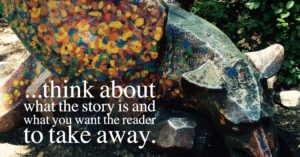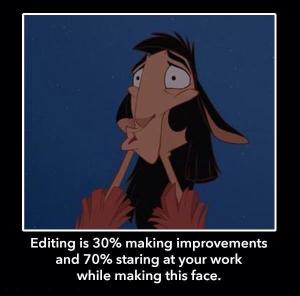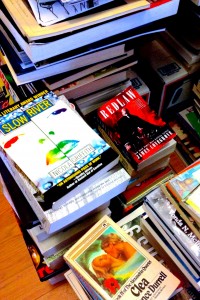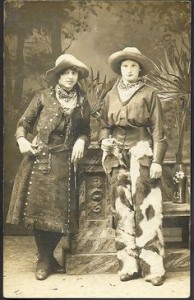
 Yesterday I taught a day-long workshop on rewriting and editing one’s work for Clarion West. I usually do this as a two hour online workshop, so it was interesting to take the class and get a chance to really flesh it out, particularly since I can use this version to create an on-demand version.
Yesterday I taught a day-long workshop on rewriting and editing one’s work for Clarion West. I usually do this as a two hour online workshop, so it was interesting to take the class and get a chance to really flesh it out, particularly since I can use this version to create an on-demand version.
As with all writing advice, mileage will vary according to the individual. The best thing as a writer that you can do is to pay attention to your own process and make it more effective. Experiment with lots of things, identify the practices that work, and incorporate them into your process. Keep experimenting, mixing things up a little, every once in a while, writing to the sound of whale songs, or dictating while hiking, or using a pen rather than the keyboard — it doesn’t matter what as long as you keep testing things in a way that lets you grow as a writer.
...

I thought long and hard about what to write about for this guest post opportunity. It’s like a bizarre Open Mic Night thing. Most of you don’t know me, but I can’t see my hecklers until it’s too late. So what to do? Try to be pithy? Try to be funny? Then the Meme Card came up on Facebook… Editing is 30% Improvement and 70% making this face. And so…is this thing on?
There’s a lot to learn when it comes to writing. You can do it for years and years and still learn stuff (in fact, my opinion is that you should always be learning stuff). I’ve done quite a bit of short story work for…a while…now, as well as working on braided novels and a couple of other formats. And while those are great, I’m currently doing the final edit on my novel before it’s published. And, well, FACE.
Doing a solo novel, especially for the first time, is so different from anything else I’ve ever done. First was the editorial phone call, which – while supportive also made me wonder what the heck I was thinking sending out this…thing. When the manuscript came back, I prepared for the red, but was a complete wuss about looking at it. Fortunately, there are whole pages that don’t have marks on them…and I’ll take what I can get – but still…ow. What made it better? Was hearing J. Kathleen Cheney say, “My editor made me rewrite the back half of my book…”

Now, I’m in the process of a strange hybrid editing…thing. I had my electronic file of the manuscript. I had the track changes file from Cheney, and the paper edits. Time to learn a new skill – which I did. I combined the two electronic files first and creating yet another file (in Word 2007 and up, it’s in the “Review” ribbon under “Compare” nifty little trick). Now, while I’m inputting my paper edits mostly from my publisher/editor, but some I made one my own, I also have Cheney’s notes. Made my life easier, but still…there’s the FACE.

So listen to your editors. They’re like Mothers. They know what they’re talking about, and they know what’s good for you, and just maybe help make that 30/70% ratio will skew higher.
Bio: Rhonda Eudaly lives in Arlington, Texas with her husband, and two dogs. She’s ventured into several industries and occupations for a wide variety of experience. She has a well-rounded publication history in both fiction and non-fiction many of which can be found on www.RhondaEudaly.com.
Want to write your own guest post? Here’s the guidelines.
#sfwapro
Enjoy this writing advice and want more content like it? Check out the classes Cat gives via the Rambo Academy for Wayward Writers, which offers both on-demand and live online writing classes for fantasy and science fiction writers from Cat and other authors, including Ann Leckie, Seanan McGuire, Fran Wilde and other talents! All classes include three free slots.
...
 In reading for Women Destroy Fantasy, I’ve cleared about two hundred stories away so far, and there’s still about a hundred I have yet to read. Some amazing stuff, some familiar names, and all in all, a slush pile that is full enough of solid stories that I could fill several issues. It’s been a great pleasure to be elbow deep in so much excellence. So here’s a few notes on the experience so far.
In reading for Women Destroy Fantasy, I’ve cleared about two hundred stories away so far, and there’s still about a hundred I have yet to read. Some amazing stuff, some familiar names, and all in all, a slush pile that is full enough of solid stories that I could fill several issues. It’s been a great pleasure to be elbow deep in so much excellence. So here’s a few notes on the experience so far.
In my head, I have these slots:
My criteria? I want good stories that will stick in the reader’s head and keep them thinking long after they’re done reading. I want lovely prose — but not so lovely that it eclipses the story. I want heart — I’m still looking for a story in the pile that makes me cry.
Other observations:
...

So I’ll be open to submissions from March 15 through March 31 for the Women Destroying Fantasy issue. Here are some of my wants and a couple of things that will turn me off.
- I want fantasy that showcases the amazing emotional range of the genre and the spectrum of forms it can take.
- I’ll want at least one tearjerker and one humorous piece.
- I’ll want something that draws on fairytale or myth, but which does so in an amazing, interesting, and fresh way, and I’m hoping to find something that feels urban fantasy-ish as well, also in a fresh and interesting way.
- Fantasy that often hits well with me: superheroes, non-cutesy talking animals, linguistic-related, the weird.
- I like language: make yours wonderful, but never at the cost of the story.
- Your character should make me care about their fate (and for this issue, probably a female protagonist is, quite frankly, probably going to be a better fit).
- I’ll want at least one piece with an utterly amazing landscape, that immerses me in a fantasy world that delights my heart.
- Diversity does matter to me. It doesn’t trump quality, but when you’re going to be up against the very best, score your points where you can.
I don’t want retellings of D&D adventures. Or pirates. I really don’t like pirates (got exposed to an awful lot of fantasy pirate stories while at Fantasy Magazine) and I’m not particularly fond of zombies. Typos are another big turn-off: proofread your work.
This is not a time to go for the low-hanging fruit or play it safe. I have four, count ’em, four slots. Send me something — but make it the very best you have, something that is unique to your voice, something that you and only you could write.
...
I blogged a couple of days ago about arranging stories and my philosophy for such arrangements. I wanted to show those principles in action by looking at the two ToCs for the book Near + Far.
As you may know, the book is divided into two parts, near future stories and far future stories. This allowed us to take advantage of the old Ace double format, where each half is one side of the book. It also meant creating two tables of contents, one for each section.
So here’s the order for the Near section, with some explication:
The collection leads off with the story, “The Mermaids Singing, Each to Each”. The story originally appeared in Clarkesworld, and is one of my favorites, as well as garnering significant critical attention. It’s a story that I knew would be familiar to many of my fans, and perhaps remind them of what they liked about my work, setting them in the proper mood for the rest of the stories. For readers who were new to the work, I knew that this was a good strong start.
The second story is, “Peaches of Immortality,” which originally appeared in Lightspeed Magazine as “The Immortality Game.” This is another strong story although it deals with a different theme than Mermaids. Like the first story, it has a somewhat ambiguous (but in this case arguably happy) ending.
“Close Your Eyes,” which originally appeared in Apex Magazine, marks a movement into more slipstreamy stuff and a venture into more experimental realms. It is a slightly odd story in that it toys a little with meta-fiction, talking about narrative conventions, and even ends with two possible endings, inviting the reader to pick the one they prefer. This seemed like a reasonable choice for a third story, in that it let me nudge the reader a little out of their presumed comfort zone.
“Therapy Buddha,” which appeared in a collection called 2020 Visions, ontinues to present some variety in terms of theme. If I had to sum them up so far, Mermaids is about hope and love, Peaches is about the perils of dwelling in the past, Close Your Eyes is about dependency, and this story is about loneliness and the relationships with the inanimate created by such circumstances. Notice that so far there is not a lot of variety in terms of length. While the other side has several flash pieces, this side only has one.
“Ms. Liberty gets a Haircut” is a change in emotion. It’s a story that, although it has a serious subject, also deals a lot with wordplay and pop-culture references, and is generally a lot of fun for readers. I felt that by now the readers probably had enough misery and ambiguity, and perhaps might like a little play.
“10 New Metaphors for Cyberspace,” a flash piece, marks what is close to the middle of the book. It is a prose poem of sorts, and so seemed a good accompaniment for Ms. Liberty, as well as also being somewhat experimental.
“Memories of Moments, Bright as Falling Dtars,” moves us back into more straightforward narratives and also away from the comic moments that its two predecessors held.
“Real Fur” is one of my earlier stories, but one that I like very much, and which has turned out to be a favorite with a number of readers, I suspect for its tactile qualities. It’s the first of the trio of what I consider the slightest stories of this section, followed by “Not Waving, but Drowning,” and “Vocobox,” which was one of the very first stories that I published.
After that I hit the last two stories in the book, and wanted to finish with fairly strong ones. I chose for the next-to-last story, the story “Long Enough and Just So Long,” which originally appeared in lightspeed and which is, I think one of my best. Or at least one of my favorites.
The final story, “Legends of the Gone,” is not the best in the collection or even close, but it is one that creates an impression that I wanted the reader to close with, a story about endings and goodbyes. It seemed like a very good choice for the final story of this section, particularly knowing that most readers would turn the book over and begin the Far section at that point.
Questions? Comments? What might you have done differently?
...
Want access to a lively community of writers and readers, free writing classes, co-working sessions, special speakers, weekly writing games, random pictures and MORE for as little as $2? Check out Cat’s Patreon campaign.

"(On the writing F&SF workshop) Wanted to crow and say thanks: the first story I wrote after taking your class was my very first sale. Coincidence? nah….thanks so much."

(science fiction, story) When he realized how upset his wife was, George wondered if he might have miscalculated. Normally a quiet and loving partner, she was unpacking the dishwasher with a great deal of clattering and muttering.


This site is protected by reCAPTCHA and the Google Privacy Policy and Terms of Service apply. This site is a participant in the Amazon Services LLC Associates Program, an affiliate advertising program designed to provide a means for sites to earn advertising fees by advertising and linking to Amazon.com.